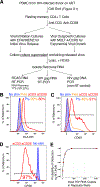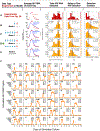Principles Governing Establishment versus Collapse of HIV-1 Cellular Spread
- PMID: 31761718
- PMCID: PMC6948011
- DOI: 10.1016/j.chom.2019.10.006
Principles Governing Establishment versus Collapse of HIV-1 Cellular Spread
Abstract
A population at low census might go extinct or instead transition into exponential growth to become firmly established. Whether this pivotal event occurs for a within-host pathogen can be the difference between health and illness. Here, we define the principles governing whether HIV-1 spread among cells fails or becomes established by coupling stochastic modeling with laboratory experiments. Following ex vivo activation of latently infected CD4 T cells without de novo infection, stochastic cell division and death contributes to high variability in the magnitude of initial virus release. Transition to exponential HIV-1 spread often fails due to release of an insufficient amount of replication-competent virus. Establishment of exponential growth occurs when virus produced from multiple infected cells exceeds a critical population size. We quantitatively define the crucial transition to exponential viral spread. Thwarting this process would prevent HIV transmission or rebound from the latent reservoir.
Keywords: Allee effect; HIV; critical threshold; exponential growth; latency; latent reservoir; mathematical modeling; population dynamics; rebound; viral dynamics.
Published by Elsevier Inc.
Conflict of interest statement
DECLARATION OF INTERESTS
The content of this publication does not necessarily reflect the views or policies of the Department of Health and Human Services or the Department of Energy, nor does mention of trade names, commercial products, or organizations imply indorsement by the U.S. Government. The authors declare no competing interests.
Figures







Comment in
-
HIV Latency: Stochastic across Multiple Scales.Cell Host Microbe. 2019 Dec 11;26(6):703-705. doi: 10.1016/j.chom.2019.11.010. Cell Host Microbe. 2019. PMID: 31951580
References
-
- Altschul SF, Gish W, Miller W, Myers EW, and Lipman DJ (1990). Basic local alignment search tool. J. Mol. Biol 215, 403–410. - PubMed
-
- Baba M, Miyake H, Okamoto M, Iizawa Y, and Okonogi K (2000). Establishment of a CCR5-expressing T-lymphoblastoid cell line highly susceptible to R5 HIV type 1. AIDS Res. Hum. Retroviruses 16, 935–941. - PubMed
-
- Banga R, Procopio FA, Noto A, Pollakis G, Cavassini M, Ohmiti K, Corpataux J-M, de Leval L, Pantaleo G, and Perreau M (2016). PD-1(+) and follicular helper T cells are responsible for persistent HIV-1 transcription in treated aviremic individuals. Nat. Med 22, 754–761. - PubMed
Publication types
MeSH terms
Associated data
Grants and funding
LinkOut - more resources
Full Text Sources
Other Literature Sources
Medical
Molecular Biology Databases
Research Materials

